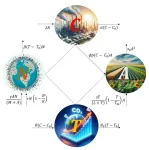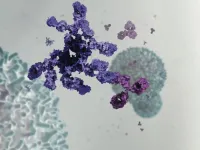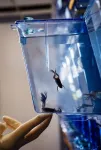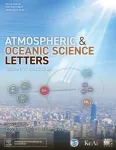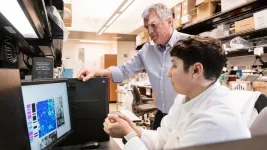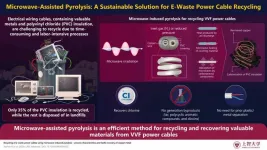(Press-News.org) WASHINGTON, Nov. 26, 2024 – Human activities are causing atmospheric carbon dioxide (CO2) levels to rise, which increases the global average surface temperature—and poses a threat to crop growth. Escalating concerns about climate change’s impact on global food security inspired researchers from Banaras Hindu University in India to create a way to explore how these factors influence crop yields.
In Chaos, from AIP Publishing, the researchers share a mathematical model created to capture the nonlinear relationships between CO2, temperature, human population, and crop growth. Increasing evidence of chaotic and complex dynamics within ecological systems led them to use both autonomous and nonautonomous models to gain a deeper understanding of seasonal variations and potential mitigation strategies, such as developing temperature-tolerant crops.
The team’s study integrates key concepts of the dynamics of atmospheric CO2, rising temperatures, human population, and crop yield.
“We’ve considered how the rising CO2 levels will initially boost crop growth through the ‘CO2 fertilization effect,’ but once temperatures exceed a critical threshold the heat stress will reduce yields,” said A.K. Misra. “A nonautonomous system with seasonal variations reveals complex behaviors like periodic oscillations and chaos—and highlights the unpredictability of crop responses to rising temperatures.”
The concepts considered by the team are central to understanding the complexity of climate and crop interactions that may lead to unexpected extreme outcomes. Their work shows the importance of managing these variables effectively to sustain agricultural productivity.
“Our findings reveal a critical threshold for anthropogenic CO2 emission, beyond which crop yield starts to decrease significantly,” said Misra. “It depends on the cultivated crop varieties—different varieties exhibit varying responses, so the results may not apply uniformly across all crops.”
The team’s work highlights the urgent need to address CO2 emissions to maintain agricultural productivity. It also uncovers a promising strategy to mitigate crop loss caused by climate change: developing crop varieties with a higher temperature tolerance.
By breeding or engineering crops to withstand elevated temperature, farmers can better adapt to changing environmental conditions to protect the crop yield. This adaptability is especially crucial in the face of global warming—making climate-resistant agriculture a key factor in ensuring food security. One surprising takeaway from the study is the extent to which relatively small increases in temperature may impact crop yields.
This work has applications for agriculture in the face of climate change.
“By identifying critical temperature thresholds, we get insights into when crop yields may begin to decline, which will guide policymakers in making more beneficial strategies,” said Misra. “Our findings suggest breeding or using crops with increased temperature tolerance should be considered as a strategy to maintain productivity under elevated CO2 levels.”
Understanding the chaotic behavior of crop systems helps to improve yield predictions and inform adaptive farming practices for managing seasonal and climatic variability.
Next steps for the team involve refining their model to include more variables like insect population, water availability, soil quality, and nutrient levels, which also impact crop yield under climate change.
“Further experimental validation with real-world data will help calibrate our model more accurately, while development of region-specific models will enable localized predictions and strategies,” said Misra.
###
The article “Impact of elevated carbon dioxide and temperature on crop yield: A study of autonomous and nonautonomous systems” is authored by A.K. Misra, Akash Yadav, and Anjali Jha. It will appear in Chaos on Nov. 26, 2024 (DOI: 10.1063/5.0225698). After that date, it can be accessed at https://doi.org/10.1063/5.0225698.
ABOUT THE JOURNAL
Chaos is devoted to increasing the understanding of nonlinear phenomena in all areas of science and engineering and describing their manifestations in a manner comprehensible to researchers from a broad spectrum of disciplines. See https://aip.scitation.org/journal/cha.
###
END
Can we avert the looming food crisis of climate change?
Mathematical model captures the relationship between carbon dioxide, temperature, human population, and crop growth—and reveals a critical threshold
2024-11-26
ELSE PRESS RELEASES FROM THIS DATE:
Alcohol use and antiobesity medication treatment
2024-11-26
About The Study: This cohort study among individuals participating in a weight loss program found that nearly half of those consuming alcohol at baseline decreased their alcohol use after anti-obesity medication initiation. There may be properties of anti-obesity medications that lead to reduced use. For example, naltrexone decreases cravings for alcohol and glucagon-like peptide-1 receptor agonists (GLP-1 RAs) may attenuate the rewarding effects of alcohol, similar to food.
Corresponding Author: To contact the corresponding author, Lisa R. Miller-Matero, PhD, email lmatero1@hfhs.org.
To access the embargoed study: Visit our For The Media website at ...
Study reveals cause of common cancer immunotherapy side effect
2024-11-26
A multinational collaboration co-led by the Garvan Institute of Medical Research has uncovered a potential explanation for why some cancer patients receiving a type of immunotherapy called checkpoint inhibitors experience increased susceptibility to common infections.
The findings, published in the journal Immunity, provide new insights into immune responses and reveal a potential approach to preventing the common cancer therapy side effect.
“Immune checkpoint inhibitor therapies have revolutionised cancer treatment ...
New era in amphibian biology
2024-11-26
Amphibians hold a significant place in evolution, representing the transition from aquatic to terrestrial lifestyles. They are crucial for understanding the brain and spinal cord of tetrapods—animals with four limbs, including humans. A group of scientists led by a team at the Institute of Science and Technology Austria (ISTA) now shows how harmless viruses can be used to illuminate the development of the frog nervous system. The results have now been published in Developmental Cell.
Virus. When you hear the word, you probably shudder. But not all viruses are bad or cause disease. Some are even used for therapeutic ...
Harbor service, VAST Data provide boost for NCSA systems
2024-11-26
The National Center for Supercomputing Applications and VAST Data are giving supercomputing system Delta and the newly launched DeltaAI a boost in their storage and application performance.
NCSA launched Harbor, a service that provides very fast storage for global home and software directories across all NCSA open-science resources. Its deployment has led to a 400% increase in application launch performance for the Delta system, among many other gains.
Over the last two years, we’ve seen a significant increase in ...
New prognostic model enhances survival prediction in liver failure
2024-11-26
Researchers have unveiled a groundbreaking advancement in liver failure care: the CATCH-LIFE-MELD score (Chinese Acute-on-Chronic Liver Failure Consortium (CATCH-LIFE)-MELD score). This innovative tool, developed by an international team led by Xia Yu and colleagues, enhances the accuracy of predicting short-term survival outcomes for patients suffering from acute-on-chronic liver failure (ACLF). The study, published in eGastroenterology, promises to revolutionize patient management and treatment planning for this life-threatening condition.
“ACLF presents unique challenges due to its rapid progression and high mortality rates,” said Dr. Yu Shi, senior researcher at Zhejiang University ...
China focuses on improving air quality via the coordinated control of fine particles and ozone
2024-11-26
A recent special issue of the journal Atmospheric and Oceanic Science Letters has brought together some of China's top scientists to provide a picture of the latest progress in understanding and controlling air pollution.
Fine particulate matter, referred to as PM2.5, and ground-level ozone (O3) are the main pollutants degrading the air quality of China’s cities and wider urban regions. Both have serious human health effects, such as heart disease, asthma, and lung damage.
The World Health Organization (WHO) provides clear guidelines regarding acceptable concentrations ...
Machine learning reveals behaviors linked with early Alzheimer’s, points to new treatments
2024-11-26
SAN FRANCISCO—November 26, 2024—Subtle signs of Alzheimer’s disease can emerge decades before a diagnosis—often in the form of irregular behaviors that reflect very early stages of brain dysfunction.
But until now, identifying and measuring these slight behavioral changes in a scientific way hasn’t been feasible, not even when studying Alzheimer’s in mice.
In a study published in Cell Reports, a team of scientists at Gladstone Institutes used a new video-based machine learning tool to pinpoint ...
Novel gene therapy trial for sickle cell disease launches
2024-11-26
UCSF Benioff Children's Hospital Oakland is enrolling patients in an innovative clinical trial that seeks to cure sickle cell disease. The trial is the first in the U.S. to apply non-viral CRISPR-Cas9 gene-editing technology in humans to directly correct the genetic mutation that causes the disease.
The research involves taking the patient’s blood stem cells to correct the mutation and returning those edited cells to the patient through a bone marrow transplant. It’s hoped the corrected blood stem cells will then multiply and create a new blood system, one free of sickle cell.
“This ...
Engineering hypoallergenic cats
2024-11-26
Gene editing could create hypoallergenic cats, according to a sequence analysis of the protein that triggers allergies to cats. Some 15% of people are allergic to cats, and symptoms can be severe. Martin D. Chapman and colleagues investigated CH1 and CH2, genes that code for the allergen, Fel d 1. Cats produce Fel d 1 in their sebaceous, salivary, perianal, and lachrymal glands. The function of Fel d 1 is unknown but comparisons of Fel d 1 sequences and homologs from 276 domestic or exotic cats—including cougars, cheetahs, lions, tigers, and jaguars, among others—suggests that CH1 and CH2 have been under active selection, and ...
Microwave-induced pyrolysis: A promising solution for recycling electric cables
2024-11-26
The demand for electronics has led to a significant increase in e-waste. In 2022, approximately 62 million tons of e-waste were generated, marking an 82% increase from 2010. Projections indicate that this figure could rise to 82 million tons by 2030. E-waste contains valuable materials such as metals, semiconductors, and rare elements that can be reused. However, in 2022, only 22.3% of e-waste was properly collected and recycled, while the remaining materials, estimated to be worth almost $62 billion, were discarded in landfills. Although efforts to improve e-waste recycling continue, the process remains labor-intensive, and a significant portion of e-waste ...
LAST 30 PRESS RELEASES:
Norbert Holtkamp appointed director of Fermi National Accelerator Laboratory
New agentic AI platform accelerates advanced optics design
Biologists discover neurons use physical signals — not electricity — to stabilize communication
Researchers discover that a hormone can access the brain by hitchhiking
University of Oklahoma researcher awarded funding to pursue AI-powered material design
Exploring how the visual system recovers following injury
Support for parents with infants at pediatric check-ups leads to better reading and math skills in elementary school
Kids’ behavioral health is a growing share of family health costs
Day & night: Cancer disrupts the brain’s natural rhythm
COVID-19 vaccination significantly reduces risk to pregnant women and baby
The role of vaccination in maternal and perinatal outcomes associated with COVID-19 in pregnancy
Mayo Clinic smartwatch system helps parents shorten and defuse children's severe tantrums early
Behavioral health spending spikes to 40% of all children’s health expenditures, nearly doubling in a decade
Digital cognitive behavioral treatment for generalized anxiety disorder
Expenditures for pediatric behavioral health care over time and estimated family financial burden
Air conditioning in nursing homes and mortality during extreme heat
The Alps to lose a record number of glaciers in the next decade
What makes a good proton conductor?
New science reporting guide published for journalists in Bulgaria
New international study reveals major survival gaps among children with cancer
New science reporting guide published for journalists in Turkey
Scientists develop a smarter mRNA therapy that knows which cells to target
Neuroanatomy-informed brain–machine hybrid intelligence for robust acoustic target detection
Eight SwRI hydrogen projects funded by ENERGYWERX
The Lundquist Institute and its start-up company Vitalex Biosciences Announces Strategic Advancement of Second-Generation fungal Vaccine VXV-01 through Phase 1 Trials under $40 Million Competitive Con
Fine particles in pollution are associated with early signs of autoimmune disease
Review article | Towards a Global Ground-Based Earth Observatory (GGBEO): Leveraging existing systems and networks
Penn and UMich create world’s smallest programmable, autonomous robots
Cleveland researchers launch first major study to address ‘hidden performance killer’ in athletes
To connect across politics, try saying what you oppose
[Press-News.org] Can we avert the looming food crisis of climate change?Mathematical model captures the relationship between carbon dioxide, temperature, human population, and crop growth—and reveals a critical threshold
